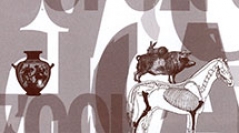

 Anthropozoologica
46 (1) - Pages 27-46
Anthropozoologica
46 (1) - Pages 27-46The Enoque rock-shelter, in the Serra das Confusões (South-Eastern Piauí), yielded a very well preserved complex of graves dating from between 7570 and 6660 years BP and concerning about seventeen peoples, mainly young children, whose corpses were buried upon a very large engraved stone. The human remains are associated with an abundant and various funerary material, namely numerous adornments made of hard animal material. The most important are collars, made of perforated teeth (canines and incisors) of various Felids (Panthera onca, Felis concolor, Felis pardalis), and of about 600 canines of the small Canid Cerdocyon thous ; there are numerous collars of vegetal beards. Another very important kind of adornments are pendants : 145 are made from the metatarsals of the small Cervid Mazama gouazoubira, and some other are made from radii of large birds, a plate of a turtle and shells of mollusks. Other remains are several samples of enigmatic pieces constituted of armadillo dermic bones incrusted on clay fragments, large Gastropods, frequently colored with ochre, of the genus Megalobulimus, and numerous large blocks of ochre. Some unworked animal remains are present, like mandibular fragments of the peccary Dicotyles tajacu, mandibles of the neotropical porcupine Coendu prehensilis, antlers and adult and juvenile metapodials of Mazama gouazoubira. Such a rich, abundant and various funerary material and the fact that the same place was used at several times for multiple burials make the Toca do Enoque an exceptional site. This site was probably in the center of the social and spiritual life of that group of hunters-collectors who lived in the North-Eastern Brazil more than 6600 years ago.
Prehistory, Lower Holocene, Northeastern Brazil, burials, adornments, pendants, perforated teeth, Cerdocyon thous, bone industry, Mazama.